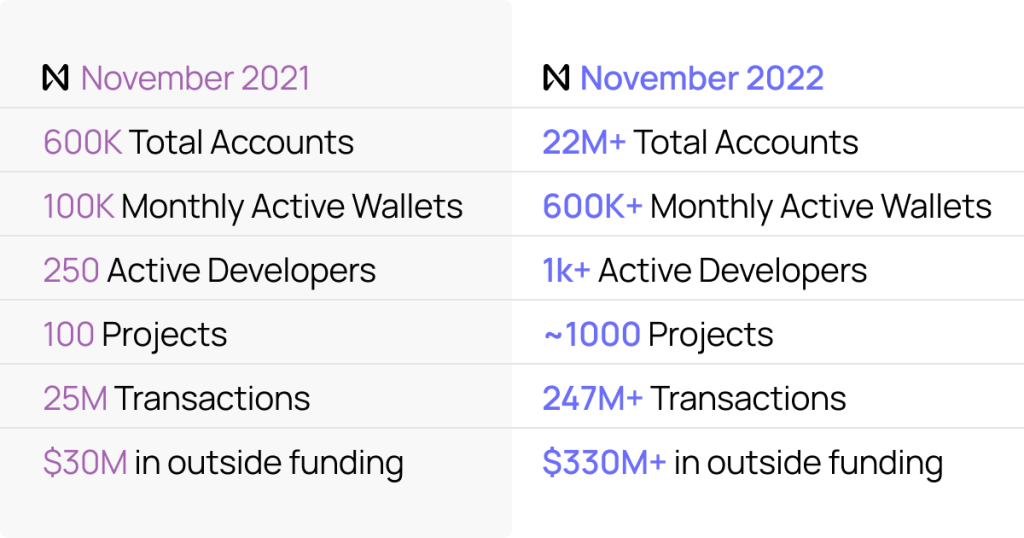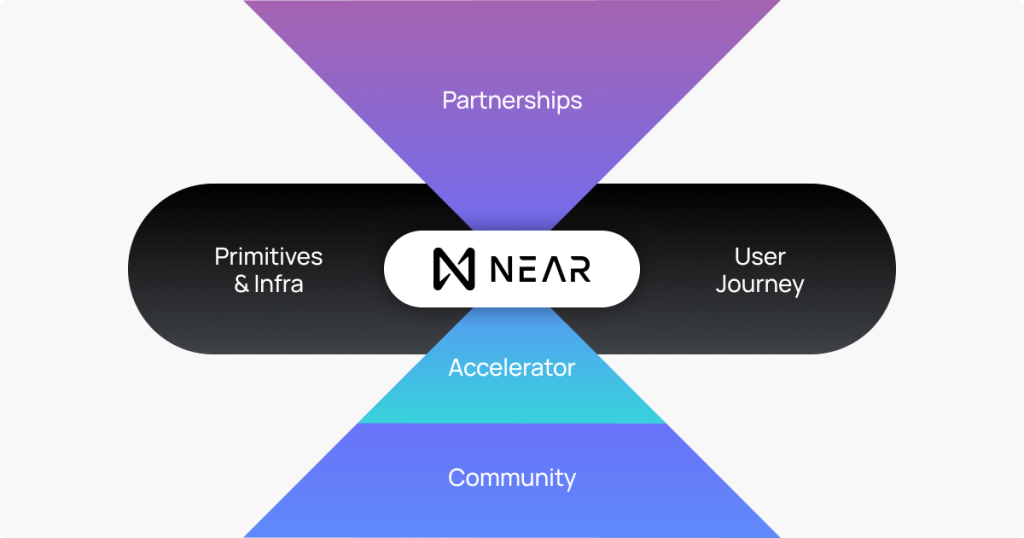The recent stream of news clearly demonstrates that the world needs Web3. Trust in legacy institutions is breaking down, individual privacy and individual freedom are equally at risk, and the major Web2 platforms we use every day have become monopolies that focus on profit, not people.
Yet Web3 also hasn’t fully delivered on its promise to open the web. While important progress has been made, much more needs to be done for this technology to deliver fairer, freer digital systems. Today’s Web3 suffers from inaccessible user experience, siloed applications which are difficult to discover, few real-world use cases, and technology tribalism. Put simply, too much hype and not enough value for users.
Since 2018, NEAR has focused on building scalable, secure technology and infrastructure that is easy to use and enables developers to freely create usable applications. Since launching Mainnet in late 2020, the NEAR ecosystem has made incredible progress, becoming one of the top layer-one blockchains with 22 million accounts, 600K monthly active wallets (active defined as 2+ transactions), and 15x growth in users and projects just in the last year. And despite chaos in the market and a major downturn in recent months, NEAR Foundation has sufficient capital to sustain at least five years of operations in bear market conditions thanks to responsible treasury management.

While Web3 has yet to deliver on its promises, NEAR Foundation believes that NEAR is the only ecosystem where Web3 promises can be delivered and where mainstream adoption can happen. All the fundamentals have been established for some time and NEAR is charging full-speed ahead into its next growth phase in 2023. This post will cover NEAR’s convictions heading into next year, the strategic approach to drive our next phase, and a look ahead at new areas of product and development.
Fundamentals and Convictions
- NEAR has the best technology in Web3. Provably scalable, easy to onboard and use, developer friendly, secure, and decentralized, with the most advanced account model and onboarding in the blockchain space.
- NEAR has world-class talent and ample runway. From the core teams at the Foundation and Pagoda, to the incredible NEAR Foundation Council and advisors, to the diverse group of brilliant entrepreneurs building companies, apps, and funds on NEAR, some of the best talent in the world is here on NEAR. And thanks to the Foundation’s responsible treasury management, core ecosystem operations and funding are well-positioned to run for many years to come.
- Achieving mainstream adoption is about users. Not TVL, not flashy headlines, not cultish maximalism. NEAR focuses on what matters for the long term and the bear market will separate the high quality projects from the ones fueled mostly by hype.
- Web 2.5 will get us there. Sweatcoin proved that NEAR can support an app with tens of millions of users on open web infrastructure. This is the next phase of adoption: helping another generation of Web2 apps and communities take advantage of the opportunities Web3 offers while providing a richer, more sustainable experience to their users.
Strategic Approach

Enabling NEAR to make the most of these convictions in today’s climate means committing to the following goals over the next year.
Growing usage on NEAR will begin with a top-down approach focused on partnerships. The world-class business development team at the Foundation will focus on working with major applications and brands with substantial, established communities to partner with NEAR on real use cases that drive engagement, such as ticketing and earning. High-traction focus verticals include sports, entertainment, and loyalty. Major partnerships in recent months include Grupo Nutresa, Google Cloud, and Sweat Economy.
Any great Web3 ecosystem is an emergent product of a dedicated community of believers. The bottom-up, grassroots approach for the next year on NEAR will empower the community to invest in its own expansion through grants, primarily through 3 major community DAOs: Developer DAO, Marketing DAO, and Creatives DAO (visit the DAO websites to get involved). This means the NEAR Foundation will no longer directly allocate capital to projects, instead supporting the community in these decisions and further decentralizing key elements of the ecosystem. These grassroots DAOs will be supported by the NDC, which has achieved initial traction, including launching a new Governance Working Group and plans to roll out a v1 governance infrastructure for the ecosystem early next year.
In the new year, the NEAR Foundation will form an early-stage accelerator that will provide support to promising projects and founders on NEAR in areas including education, tech, hiring, legal, UX, and GTM guidance, setting them up to grow into the landmark Web3 projects of tomorrow.
Looking Ahead
With NEAR’s protocol, infrastructure, and developer tooling already well established, the next step in providing the best user experience to Web3 will be at the discovery layer: the connective tissue that connects applications, tooling, social, earning, and developer components across the open web. This stack is what we call a “blockchain operating system.”

Many of the building blocks of the blockchain operating system already exist on NEAR, either as features or apps. These include NEAR Crowd, a gig economy platform with 50% of users transacting every day, and NEAR Social, an on-chain social network with a widget framework that lets developers fork entire app frontends to build new experiences. Combined with upcoming improvements to onboarding, including from EVM wallets (which we’re calling remote accounts), native meta transactions, Keypom, and new chat/social capabilities, NEAR will deliver even more amazing value directly to developers and users.
All of these user-centric elements further up the stack, particularly at the app layer, will form the basis for a core component of the NEAR ecosystem’s product and technical focus in 2023. Pagoda, NEAR Foundation, and other key ecosystem participants will work together to deliver the best possible technology with an increasingly integrated and seamless experience for developers and end users. The goal from here is evolving NEAR to be more than just a layer-one blockchain: it will become a global blockchain operating system. It’s still early days, but building is underway and the vision is clear.
NEAR is Now
NEAR is the place where mainstream adoption of the open web will happen. Soon, anyone in the world—app users, developers, founders, creators—will be able to create without limits.
Thank you for reading our NEAR 2023 Strategy Blog Post and/or participating in the NEAR Go Forward Strategy Twitter AMA! If you have questions or comments we would love to hear them!
One of NEAR Foundation’s core missions has been to create a network that empowers users to take control of their data, their finances, and the tools to govern.
In the web3 world, this idea can be neatly summed up by one word: decentralization. This is a process whereby control and the tools to create and reimagine everything from business to creativity are progressively handed over to the contributors.
The NEAR Foundation has been steadily progressing in this mission, from the growing number of validators to the flourishing DAO community. But NEAR isn’t alone on this journey. It relies on projects in and around the ecosystem to help accelerate this mission. Enter Aurora.
This project, started originally by a core team of NEAR developers, is now helping build bridges to other ecosystems and accelerating the adoption and decentralization in equal measure.
A Bridge Between NEAR and Ethereum
Built by NEAR Inc’s core team (now Pagoda), Aurora is an Ethereum Virtual Machine (EVM) smart contract platform that creates a bridge between Ethereum and NEAR. An EVM, for those who don’t know, is best thought of as a decentralized computer that allows anyone to create a smart contract on the Ethereum network.
Although an EVM, Aurora works on top of the NEAR blockchain, giving it all of the benefits of the NEAR blockchain: super fast, incredibly secure, and infinitely scalable transactions. That’s possible thanks to Nightshade, NEAR’s unique sharded protocol design that allows the network to process thousands of transactions per second without skipping a beat.
With Aurora, the idea is that anyone building Ethereum projects can make use of the NEAR’s speed and low fees. The Aurora EVM allows developers to make use of NEAR’s blockchain, while the platform uses NEAR’s Rainbow Bridge to transfer assets.
Let’s look at Rainbow Bridge, as this protocol is where things got started.
Aurora and Rainbow Bridge
NEAR’s core developer team wanted to create a smart contract that would perform the function of allowing tokens to flow freely between Ethereum, NEAR, and other projects. The team’s vision: create a tool that allowed assets to exist on both NEAR and Ethereum, creating a multi-chain Web3 user experience.
To do this, the team would need to create a bridge that would be completely decentralized: anyone could use it, anywhere, and at any time—without permission. The developers were able to build the bridge and now, if one wants to move an Ethereum-based token—say, a stablecoin like DAI—and use it on NEAR’s network, they can do so via the Rainbow Bridge.
Some of NEAR’s core team that had helped create Rainbow Bridge split off to continue their work. The result: Aurora—a project that now offers the bridge and a whole host of other features designed to create a global network of open-source Web3 projects.
Aurora partnerships
Other projects working to improve cross-chain accessibility have since taken notice of Aurora’s work and become partners. One example is Allbridge, an application that unites scattered blockchains by means of global interoperability across all networks. Since Allbridge partnered with Aurora, it has launched a bridge between Aurora and Terra, an open-source stablecoin network and one of the biggest cryptocurrencies by market cap.
Aurora is also playing a big part in decentalized finance (DeFi) growth in the NEAR ecosystem. DeFi refers to the peer-to-peer financial services built on public blockchains, and is one of the most active crypto sectors on NEAR. The NEAR community has been working tirelessly to make it easier for DeFi apps and tools to leverage the protocol’s developer-friendly advantages.
One way that Aurora has made this process much smoother and more decentralized is through its extremely low fees (so low, they’re negligible), which it achieves by using the NEAR network. A constant gripe from users about Ethereum-based DeFi products is that the fees are often too high, creating a barrier to entry for developers and end users, and creating a hurdle to Web3’s mainstream adoption.
Aurora adoption is growing so much that the team released Aurorascan, its very own version of Etherscan, the most popular Ethereum block explorer and analytics platform. Aurorascan has all of Etherscan’s features set and reliability, while giving developers the tools and data to see how Aurora’s EVM functions.
But Aurora goes beyond DeFi. The platform is also integral to the NEAR community’s NFT projects, which have exploded in popularity since 2020. When the Aurora team spoke at this year’s ETHDenver conference in February, and they were joined by members of Endemic, Chronicle, and TENKBay—all NFT platforms that have launched on the Aurora EVM and NEAR Protocol.
Future Aurora developments
So what does Aurora have up its sleeve for the future? Well, Aurorascan is still in beta mode, so more features will be added to that platform. And the team is also working to build new bridges, which will be announced in the coming months.
There are also plans to allow NFTs to be able to hop between Ethereum and NEAR. You can keep up to date on all things Aurora on its Medium page.
All this and more will help those wanting to take advantage of NEAR’s super fast and extremely cost-effective network, and help the dream of a truly decentralized world become a reality.
